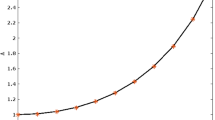Abstract
The transient pressure–rate deconvolution problem is formulated in the form of a linear convolution Volterra equation of the first kind. In addition to its ill-posedness, the problem is characterized by multiscale behavior of the solution and discontinuous input data with possibly large measurement errors (noises). These do not allow us to apply standard algorithms for solving the Volterra equation. Therefore, in most cases, deconvolution algorithms may implicitly or explicitly include regularization and take into account a priori information. In general, the solution has to satisfy certain conditions, such as positivity, monotonicity, and/or convexity. However, as is well known, the solution of the deconvolution problem satisfies an infinite system of inequalities. In this paper, we construct two effective regularization algorithms (methods) to obtain smooth approximate solutions satisfying all a priori constraints for the deconvolution problem. The convergence properties of the methods are proven. Finally, the methods are applied to a few sets of pressure–rate data with large measurement errors, and the deconvolution results of the data are discussed.











Similar content being viewed by others
References
van Everdingen AF, Hurst W (1949) The application of the Laplace transformation to flow problem in reservoir. Trans Am Inst Min Metall Petrol Eng 186:305–324
Bourdet D, Ayoub JA, Pirard YM (1989) Use of pressure derivative in well-test interpretation. SPE Form Eval 4(2):293–302
von Schroeter T, Hollaender F, Gringarten A (2004) Deconvolution of well test data analysis as a nonlinear total least squares problem. SPE J 9(4):375–390
Kuchuk FJ, Onur M, Hollaender F (2010) Pressure transient formation and well testing: convolution, deconvolution and nonlinear estimation. Developments in petroleum science, vol 57. Elsevier, Amsterdam
Pimonov EA, Onur M, Kuchuk FJ (2009) A new robust algorithm for solution of pressure/rate deconvolution problem. J Inverse Ill Posed Probl 17:611–627
Coats KH, Rapport LA, McCord JR, Drews WP (1964) Determination of aquifer influence function from field data. Trans SPE (AIME) 231:1417–1424
Vasin V, Skorik G, Pimonov E, Kuchuk F (2010) New regularization algorithms for solving the deconvolution problem in well test data interpretation. Appl Math 1:387–399
Levitan MM (2005) Practical application of pressure–rate deconvolution to analysis of real well test. SPE Reserv Eval Eng 8(2):113–121
Leontiev AF (1980) Sequences of polynomials from exponents. Nauka, Moscow (in Russian)
Ivanov VK, Vasin VV, Tanana VP (2002) Theory of linear Ill-posed problems and its applications. VSP, Utrecht
Tikhonov AN, Arsenin VY (1977) Methods of solving Ill-posed problems. Nauka English translation. Wiley, Moscow
Vasilyev FP (1988) Numerical methods for solving extremal problems. Nauka, Moscow (in Russian)
Nocedal J, Wright SJ (2006) Numerical optimization, 2nd edn. Springer, Berlin
Skorik G, Vasin V (2014) Pressure/rate deconvolution problem and reconstruction of solution satisfying to all a priori constraints. In: Szczygiel I, Novak AJ, Rojchyk M (eds) Conference proceedings of 8\(\text{ th }\) international conference on inverse problems in engineering. Institute of Thermal Technology, Silesian University Technology, Krakow, Glivice-Krakow, 12–15 May 2014, pp 343–352
Acknowledgments
The work was supported under the RFBR Grant, project no. 15-01-00629.
Author information
Authors and Affiliations
Corresponding author
Rights and permissions
About this article
Cite this article
Skorik, G.G., Vasin, V.V. & Kuchuk, F. A new technique for solving pressure–rate deconvolution problem in pressure transient testing. J Eng Math 101, 189–200 (2016). https://doi.org/10.1007/s10665-016-9854-x
Received:
Accepted:
Published:
Issue Date:
DOI: https://doi.org/10.1007/s10665-016-9854-x
Keywords
- Deconvolution problem
- Exponential basis
- Pressure transient test interpretation
- Quasi-solution method
- Tikhonov regularization




